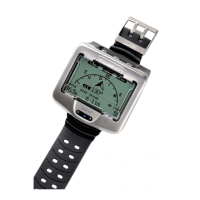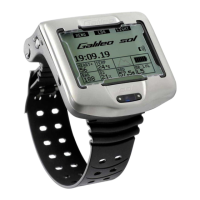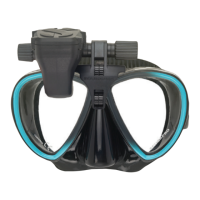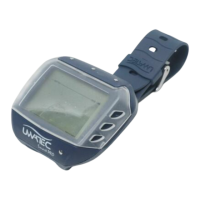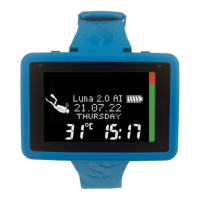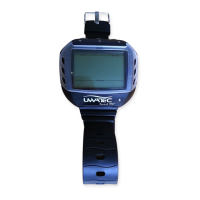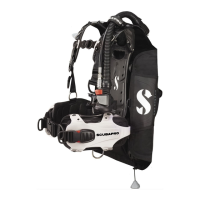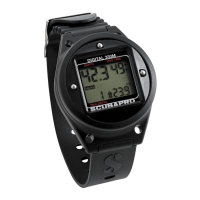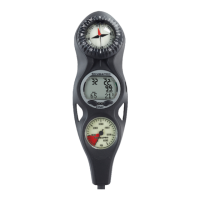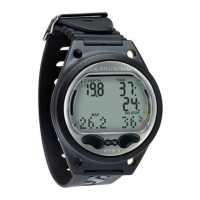Do you have a question about the Uwatec Galileo 2 and is the answer not in the manual?
Details on the G2's rechargeable Li-Ion battery and charging process.
Describes the four operating modes: Charging, Sleep, Surface, and Dive.
Instructions on how to power on the G2 and initial setup.
Explains the NO DIVE symbol and its implications.
Details the no-fly time calculation and its importance.
Describes the SOS mode and its consequences.
How to add emergency information using LogTRAK.
How to customize the time-of-day display with owner info.
Steps for physically mounting the transmitter onto a regulator.
Overview of patented underwater monitors for dive customization.
Instructions on how to manually power off the G2.
How to change gas content and partial pressure limits.
Setting gas mix for normal one-tank diving (21-100% O2).
Enabling PMG for multi-gas diving.
Enabling Trimix mode for gas content presentation.
Enabling CCR mode for rebreather diving.
Disabling the MOD setting.
Overview of dive settings and parameters.
Selecting preferred microbubble (MB) levels for dive safety.
Choosing between Scuba, Gauge, and Apnea modes.
Editing safety stop timer duration and start mode.
Setting the maximum limit for oxygen partial pressure.
Adjusting for salt or fresh water for depth measurement.
Presetting a default time to reset to air after a nitrox dive.
Allowing short surface orientations while logging a single dive.
Information and settings for Oxygen Toxicity Units (OTUs).
Activating stealth mode to disable audible alarms.
Enabling Sidemount mode for two-tank diving.
Enabling CCR mode for rebreather diving.
Enabling Trimix mode for gas content presentation.
Enabling Profile Dependent Intermediate Stops (PDIS).
Enabling Predictive Multigas (PMG) for multiple tanks.
Settings for the Apnea dive mode.
Setting dual depth alarms for Apnea mode.
Setting incremental depth warnings for Apnea mode.
Setting dive time interval warnings for Apnea mode.
Setting surface interval warnings for Apnea mode.
Setting ascent speed alarms for Apnea mode.
Setting low heart rate alarms for Apnea mode.
Adjusting water density for Apnea diving.
Settings related to the digital compass.
Launching the compass screen.
Setting compass timeout or push-on/push-off.
Setting magnetic declination for compass accuracy.
Checking and adjusting current elevation.
Customizing which warnings to have active.
Setting the maximum dive depth warning value.
Warning when CNS O2 reaches 75%.
Warning when no-stop time reaches 2 minutes.
Warning when first mandatory decompression stop appears.
Setting the maximum dive time warning.
Warning when tank pressure reaches a defined level.
Warning when Remaining Bottom Time (RBT) drops to 3 minutes.
Warning for lost wireless tank pressure signal.
Warning when no longer in the MB no-stop phase.
Warning if a depth shallower than required MB stop is reached.
Warning when MB level is reduced due to ascent.
Warning when LO no-stop time reaches 2 minutes with active MB level.
Warning when about to enter decompression with active MB level.
Changing time, format, date, and time zone.
Setting a wake-up alarm.
Setting time format, time, and date.
Adjusting time zone settings.
Accessing device info, gas integration, backlight, etc.
Displays device ID, hardware, software, and battery level.
Editing gas integration related settings.
Setting the tank reserve pressure limit.
Selecting RBT 0min as warning or alarm.
Adjusting workload calculation sensitivity.
Replacing oxygen bar graph with tank pressure graphic.
Overview of paired tank pressures and content.
Pairing the G2 with nearby tank transmitters.
Setting the active backlight duration.
Adjusting backlight intensity and adaptive backlight.
Turning water contacts on or off for automatic power-on.
Reverting all settings to original factory defaults.
Installing or uninstalling features.
Installing software updates for the G2.
Formatting the G2's flash disk.
Settings for customization like screen, language, owner info.
Selecting screen layout (Light, Classic, Full, Graphical).
Setting the language for displayed texts.
Choosing a personalized picture for the start-up screen.
Setting preferred units for depth, temperature, and pressure.
Estimating workload based on heart rate/breathing for dive calculations.
Viewing owner information entered via LogTRAK.
Viewing emergency information entered via LogTRAK.
Selecting different display color combinations.
Viewing saved pictures in the G2's memory.
Planning the next dive based on body's nitrogen saturation.
Planning a no-stop dive, adding surface interval time.
Planning a decompression dive, editing dive time and stops.
Accessing FAQs and manual summaries.
Activating and configuring Bluetooth communication.
Reading the logbook and dive statistics.
Organizing and viewing Apnea dive logs.
How the dive mode screen appears on the surface.
Display appearance in recreational mode after a dive.
Display appearance in PMG mode.
Gas content display in Trimix mode.
Tank pressure and content display in Sidemount mode.
Display appearance in CCR mode.
Display of surface interval, no-dive, and CNS% counters.
Summary of button functions across different dive modes.
Overview of altitude diving and warnings after a dive.
Explains altitude classes and warnings related to altitude.
How altitude affects the decompression algorithm.
Advises on safe altitude classes to reach after a dive.
Decompression procedures for mountain lake dives.
Explanation of nitrox diving and oxygen toxicity effects.
Requirements and considerations for technical diving.
How the G2 handles multiple gas mixtures.
Overview of potentially dangerous situations and alerts.
Modifying warning settings (audible, visual, both, off).
Warning trigger for exceeding maximum depth.
Warning when CNS O2 reaches 75%.
Warning when no-stop time reaches 2 minutes.
Warning when first mandatory decompression stop appears.
Setting maximum dive time warnings.
Warning when tank pressure reaches a defined level.
Warning when Remaining Bottom Time (RBT) drops to 3 minutes.
Warning for lost wireless tank pressure signal.
Warning when no longer in the MB no-stop phase.
Warning if a depth shallower than required MB stop is reached.
Warning when MB level is reduced due to ascent.
Warning when LO no-stop time reaches 2 minutes with active MB level.
Warning when about to enter decompression with active MB level.
Overview of critical alarms requiring immediate action.
Information on ideal ascent rates and warnings.
Warnings for exceeding MOD or ppO2 limits.
Warning for danger of oxygen toxicity when CNS O2 reaches 100%.
Alarm triggered when tank reserve pressure limit is reached.
Alarm for ascending above a required decompression stop.
Warning/alarm when RBT reaches 0 minutes.
Warning for low battery status, preventing dives.
Details on displayed information during a dive.
Selecting screen layout options (Light, Classic, Full, Graphical).
Understanding and using microbubble (MB) levels for dive safety.
Compares dive profiles with different MB levels.
Explanation of Profile Dependent Intermediate Stops.
Explains the purpose and benefit of PDIS.
Details the mathematical decompression model behind PDIS.
How PDIS is affected by multi-gas diving.
How PDIS is displayed and used during a dive.
Using the G2 in Gauge mode for depth, time, and temp monitoring.
Using the G2 for advanced Apnea diving.
Alternative mounting strap for thick wetsuits.
Using Smart series transmitters for tank pressure monitoring.
Features of the SCUBAPRO heart rate belt.
Requirements for PC Bluetooth connectivity.
Connecting the G2 to a charger or PC/Mac via USB.
Enabling and configuring Bluetooth for communication.
Steps to connect the G2 with LogTRAK via USB or Bluetooth.
Transferring G2 logbook data to PC/Mac via LogTRAK.
Modifying settings and reading computer info via LogTRAK.
Managing files on the G2's flash disk using PC/Mac.
Formatting the G2's flash disk.
Specifications for operating altitude, depth, clock, etc.
Recommendations for routine maintenance and care.
Steps for replacing the battery in the high-pressure transmitter.
Steps for replacing the battery in the Heart Rate Belt.
Details of the G2's 2-year warranty coverage.
Absolute Minimum Depth definition.
Average depth definition.
Central Nervous System oxygen toxicity definition.
Desaturation time definition.
Definition of time spent below 0.8m/3ft.
Refers to the main gas set for the algorithm.
Definition of time in the local time zone.
Maximum depth attained during the dive.
Microbubble definition.
SCUBAPRO's customizable algorithm levels.
Maximum Operating Depth definition.
Definition of oxygen-nitrogen mixes with >21% oxygen.
Minimum time to wait before flying after a dive.
Time to stay at current depth for direct ascent.
Oxygen.
Oxygen concentration used in calculations.
Profile Dependent Intermediate Stop definition.
Partial pressure of oxygen definition.
Maximum allowed ppO2 value.
Act of pressing a button.
Act of pressing and holding a button.
Surface interval definition.
Consequence of not respecting mandatory decompression.
Stopwatch function definition.
Depth to switch gas mixture.
Universal Time Coordinated definition.
Total Ascent Time definition.
Remaining Bottom Time definition.
Closed Circuit Rebreather definition.
Definition of a gas mixture containing O2, He, N2.
Predictive Multi Gas definition.
Oxygen Toxicity Unit definition.
Details on the G2's rechargeable Li-Ion battery and charging process.
Describes the four operating modes: Charging, Sleep, Surface, and Dive.
Instructions on how to power on the G2 and initial setup.
Explains the NO DIVE symbol and its implications.
Details the no-fly time calculation and its importance.
Describes the SOS mode and its consequences.
How to add emergency information using LogTRAK.
How to customize the time-of-day display with owner info.
Steps for physically mounting the transmitter onto a regulator.
Overview of patented underwater monitors for dive customization.
Instructions on how to manually power off the G2.
How to change gas content and partial pressure limits.
Setting gas mix for normal one-tank diving (21-100% O2).
Enabling PMG for multi-gas diving.
Enabling Trimix mode for gas content presentation.
Enabling CCR mode for rebreather diving.
Disabling the MOD setting.
Overview of dive settings and parameters.
Selecting preferred microbubble (MB) levels for dive safety.
Choosing between Scuba, Gauge, and Apnea modes.
Editing safety stop timer duration and start mode.
Setting the maximum limit for oxygen partial pressure.
Adjusting for salt or fresh water for depth measurement.
Presetting a default time to reset to air after a nitrox dive.
Allowing short surface orientations while logging a single dive.
Information and settings for Oxygen Toxicity Units (OTUs).
Activating stealth mode to disable audible alarms.
Enabling Sidemount mode for two-tank diving.
Enabling CCR mode for rebreather diving.
Enabling Trimix mode for gas content presentation.
Enabling Profile Dependent Intermediate Stops (PDIS).
Enabling Predictive Multigas (PMG) for multiple tanks.
Settings for the Apnea dive mode.
Setting dual depth alarms for Apnea mode.
Setting incremental depth warnings for Apnea mode.
Setting dive time interval warnings for Apnea mode.
Setting surface interval warnings for Apnea mode.
Setting ascent speed alarms for Apnea mode.
Setting low heart rate alarms for Apnea mode.
Adjusting water density for Apnea diving.
Settings related to the digital compass.
Launching the compass screen.
Setting compass timeout or push-on/push-off.
Setting magnetic declination for compass accuracy.
Checking and adjusting current elevation.
Customizing which warnings to have active.
Setting the maximum dive depth warning value.
Warning when CNS O2 reaches 75%.
Warning when no-stop time reaches 2 minutes.
Warning when first mandatory decompression stop appears.
Setting the maximum dive time warning.
Warning when tank pressure reaches a defined level.
Warning when Remaining Bottom Time (RBT) drops to 3 minutes.
Warning for lost wireless tank pressure signal.
Warning when no longer in the MB no-stop phase.
Warning if a depth shallower than required MB stop is reached.
Warning when MB level is reduced due to ascent.
Warning when LO no-stop time reaches 2 minutes with active MB level.
Warning when about to enter decompression with active MB level.
Changing time, format, date, and time zone.
Setting a wake-up alarm.
Setting time format, time, and date.
Adjusting time zone settings.
Accessing device info, gas integration, backlight, etc.
Displays device ID, hardware, software, and battery level.
Editing gas integration related settings.
Setting the tank reserve pressure limit.
Selecting RBT 0min as warning or alarm.
Adjusting workload calculation sensitivity.
Replacing oxygen bar graph with tank pressure graphic.
Overview of paired tank pressures and content.
Pairing the G2 with nearby tank transmitters.
Setting the active backlight duration.
Adjusting backlight intensity and adaptive backlight.
Turning water contacts on or off for automatic power-on.
Reverting all settings to original factory defaults.
Installing or uninstalling features.
Installing software updates for the G2.
Formatting the G2's flash disk.
Settings for customization like screen, language, owner info.
Selecting screen layout (Light, Classic, Full, Graphical).
Setting the language for displayed texts.
Choosing a personalized picture for the start-up screen.
Setting preferred units for depth, temperature, and pressure.
Estimating workload based on heart rate/breathing for dive calculations.
Viewing owner information entered via LogTRAK.
Viewing emergency information entered via LogTRAK.
Selecting different display color combinations.
Viewing saved pictures in the G2's memory.
Planning the next dive based on body's nitrogen saturation.
Planning a no-stop dive, adding surface interval time.
Planning a decompression dive, editing dive time and stops.
Accessing FAQs and manual summaries.
Activating and configuring Bluetooth communication.
Reading the logbook and dive statistics.
Organizing and viewing Apnea dive logs.
How the dive mode screen appears on the surface.
Display appearance in recreational mode after a dive.
Display appearance in PMG mode.
Gas content display in Trimix mode.
Tank pressure and content display in Sidemount mode.
Display appearance in CCR mode.
Display of surface interval, no-dive, and CNS% counters.
Summary of button functions across different dive modes.
Overview of altitude diving and warnings after a dive.
Explains altitude classes and warnings related to altitude.
How altitude affects the decompression algorithm.
Advises on safe altitude classes to reach after a dive.
Decompression procedures for mountain lake dives.
Explanation of nitrox diving and oxygen toxicity effects.
Requirements and considerations for technical diving.
How the G2 handles multiple gas mixtures.
Overview of potentially dangerous situations and alerts.
Modifying warning settings (audible, visual, both, off).
Warning trigger for exceeding maximum depth.
Warning when CNS O2 reaches 75%.
Warning when no-stop time reaches 2 minutes.
Warning when first mandatory decompression stop appears.
Setting maximum dive time warnings.
Warning when tank pressure reaches a defined level.
Warning when Remaining Bottom Time (RBT) drops to 3 minutes.
Warning for lost wireless tank pressure signal.
Warning when no longer in the MB no-stop phase.
Warning if a depth shallower than required MB stop is reached.
Warning when MB level is reduced due to ascent.
Warning when LO no-stop time reaches 2 minutes with active MB level.
Warning when about to enter decompression with active MB level.
Overview of critical alarms requiring immediate action.
Information on ideal ascent rates and warnings.
Warnings for exceeding MOD or ppO2 limits.
Warning for danger of oxygen toxicity when CNS O2 reaches 100%.
Alarm triggered when tank reserve pressure limit is reached.
Alarm for ascending above a required decompression stop.
Warning/alarm when RBT reaches 0 minutes.
Warning for low battery status, preventing dives.
Details on displayed information during a dive.
Selecting screen layout options (Light, Classic, Full, Graphical).
Understanding and using microbubble (MB) levels for dive safety.
Compares dive profiles with different MB levels.
Explanation of Profile Dependent Intermediate Stops.
Explains the purpose and benefit of PDIS.
Details the mathematical decompression model behind PDIS.
How PDIS is affected by multi-gas diving.
How PDIS is displayed and used during a dive.
Using the G2 in Gauge mode for depth, time, and temp monitoring.
Using the G2 for advanced Apnea diving.
Alternative mounting strap for thick wetsuits.
Using Smart series transmitters for tank pressure monitoring.
Features of the SCUBAPRO heart rate belt.
Requirements for PC Bluetooth connectivity.
Connecting the G2 to a charger or PC/Mac via USB.
Enabling and configuring Bluetooth for communication.
Steps to connect the G2 with LogTRAK via USB or Bluetooth.
Transferring G2 logbook data to PC/Mac via LogTRAK.
Modifying settings and reading computer info via LogTRAK.
Managing files on the G2's flash disk using PC/Mac.
Formatting the G2's flash disk.
Specifications for operating altitude, depth, clock, etc.
Recommendations for routine maintenance and care.
Steps for replacing the battery in the high-pressure transmitter.
Steps for replacing the battery in the Heart Rate Belt.
Details of the G2's 2-year warranty coverage.
Absolute Minimum Depth definition.
Average depth definition.
Central Nervous System oxygen toxicity definition.
Desaturation time definition.
Definition of time spent below 0.8m/3ft.
Refers to the main gas set for the algorithm.
Definition of time in the local time zone.
Maximum depth attained during the dive.
Microbubble definition.
SCUBAPRO's customizable algorithm levels.
Maximum Operating Depth definition.
Definition of oxygen-nitrogen mixes with >21% oxygen.
Minimum time to wait before flying after a dive.
Time to stay at current depth for direct ascent.
Oxygen.
Oxygen concentration used in calculations.
Profile Dependent Intermediate Stop definition.
Partial pressure of oxygen definition.
Maximum allowed ppO2 value.
Act of pressing a button.
Act of pressing and holding a button.
Surface interval definition.
Consequence of not respecting mandatory decompression.
Stopwatch function definition.
Depth to switch gas mixture.
Universal Time Coordinated definition.
Total Ascent Time definition.
Remaining Bottom Time definition.
Closed Circuit Rebreather definition.
Definition of a gas mixture containing O2, He, N2.
Predictive Multi Gas definition.
Oxygen Toxicity Unit definition.
| Display Type | LCD |
|---|---|
| Nitrox | Yes |
| pO2 max | 1.6 bar |
| Display Resolution | 320 x 240 pixels |
| Battery Type | CR2450 |
| Wireless Air Integration | Yes |
| Multiple Gases | Yes |
| Digital Compass | Yes |
| Backlight | Yes |
| Water Activation | Yes |
| Dive Modes | Air, Nitrox, Gauge |
| Altitude Adjustment | Yes |
| Depth Rating | 150 m |
| Display Size | 2.2 inches |
| Gas Mixes | Up to 3 |
| Logbook Capacity | 100 hours profile at 4-second sampling rate |
